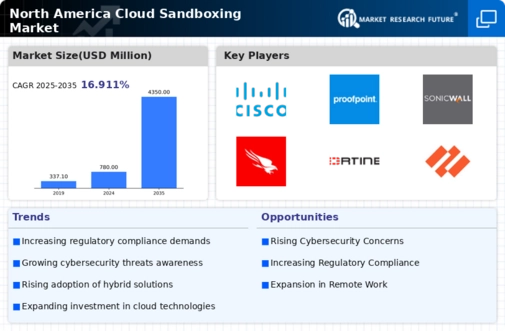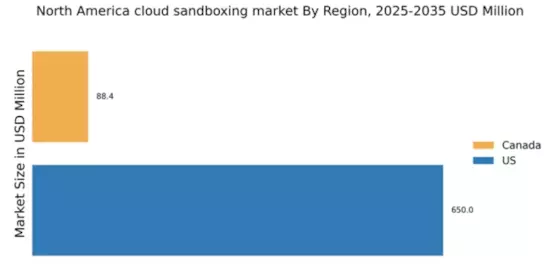Rising Cybersecurity Threats
The cloud sandboxing market in North America is experiencing growth due to the escalating frequency and sophistication of cyber threats. Organizations are increasingly recognizing the necessity of advanced security measures to protect sensitive data and systems. In 2025, it is estimated that cybercrime will cost businesses globally over $10 trillion annually, prompting a shift towards proactive security solutions. Cloud sandboxing provides a controlled environment for testing and analyzing potential threats, thereby enhancing overall cybersecurity posture. As companies face mounting pressure to safeguard their digital assets, the demand for cloud sandboxing solutions is likely to surge, driving market expansion.
Growing Need for Data Privacy
Heightened focus on data privacy regulations significantly influences the cloud sandboxing market in North America. With laws such as the California Consumer Privacy Act (CCPA) and the General Data Protection Regulation (GDPR) gaining traction, organizations are compelled to adopt stringent measures to protect personal data. The market for data privacy solutions is anticipated to grow at a CAGR of 15% through 2027, underscoring the urgency for effective compliance strategies. Cloud sandboxing serves as a vital tool for organizations to test applications and ensure they meet regulatory requirements, thereby fostering trust among consumers and stakeholders. This increasing emphasis on data privacy is likely to drive the adoption of cloud sandboxing solutions.
Investment in Security Innovation
The cloud sandboxing market in North America is being driven by increased investment in security innovation. Organizations are allocating substantial resources to develop and implement cutting-edge security technologies that can address the complexities of modern cyber threats. In 2025, it is estimated that cybersecurity spending will reach $200 billion in North America, reflecting a strong commitment to enhancing security measures. Cloud sandboxing plays a crucial role in this innovation landscape, providing a platform for testing new security solutions and strategies. As companies prioritize security innovation, the demand for cloud sandboxing solutions is likely to grow, further propelling the market forward.
Demand for Enhanced Threat Detection
The cloud sandboxing market in North America is witnessing a surge in demand for enhanced threat detection capabilities. As cyber threats evolve, traditional security measures often fall short in identifying sophisticated attacks. Cloud sandboxing offers a dynamic environment for real-time analysis of suspicious activities, enabling organizations to detect and respond to threats more effectively. In 2025, it is projected that the market for threat detection solutions will exceed $30 billion, highlighting the critical need for advanced security technologies. This growing demand for improved threat detection is expected to significantly contribute to the expansion of the cloud sandboxing market, as organizations seek to bolster their defenses against emerging threats.
Increased Adoption of Cloud Services
The cloud sandboxing market in North America is benefiting from the rapid adoption of cloud services across various industries. As organizations migrate to cloud-based infrastructures, the need for effective security measures becomes paramount. According to recent data, the cloud services market in North America is projected to reach $500 billion by 2026, indicating a robust growth trajectory. This trend necessitates the implementation of cloud sandboxing solutions to ensure that applications and data remain secure during and after migration. Consequently, the increasing reliance on cloud technologies is expected to propel the demand for cloud sandboxing solutions, further solidifying its position in the market.


















Leave a Comment